Table of Content
Let me ask you something—are you tired of fighting for top spots on Google with little success and not seeing any results? It feels frustrating, right? Well, here’s the good news: there’s an easier way to get noticed online. Long tail keywords can help you rank higher, attract the right audience, and even beat your competitors.
In this blog, I’ll show you the benefits of long tail keywords, tools for keyword research and best practical tips. Whether you’re running a blog, a small business, or an online store, using long tail keywords will benefit you and bring more visitors (and customers) to your website. But first, let’s talk about what long tail keywords actually are and why they’re so powerful.
What Are Long Tail Keywords?
Long tail keywords are longer, more specific phrases that people type into Google or other search engines. They’re different from short-tail keywords, which are usually just one or two words (like “shoes”). Long tail keywords focus on detailed queries (like “best hiking shoes for women under $100”).
For example, think about the difference between searching for “SEO tools” and “best free SEO tools for small businesses.” The first one is short, and it’s probably super competitive. But the second one is specific. It’s a target keyword at someone who knows exactly what they want and with that you can win at keyword research. That’s the benefit of long tail keywords which makes them so powerful.
The Top Benefits of Long Tail Keywords
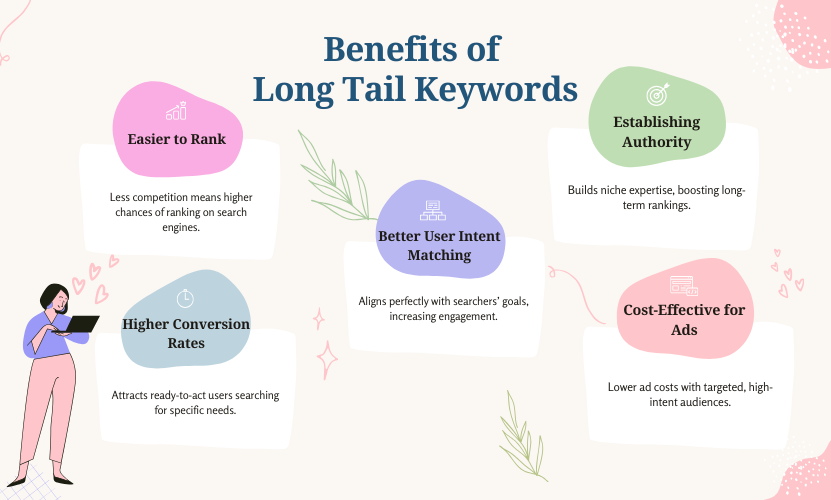
Let’s talk about the benefits of long tail keywords and why they’re a total game-changer for your website and business. Here are the biggest reasons you should start using them today:
1. Easier to Rank
When you target short tail keywords, you’re competing with big companies and established websites. Big companies spend tons of money trying to rank for them. On the other hand, the first benefit of long tail keywords is that they have less competition, so it’s easier for your content to rank higher on search engines.
Example: Competing for “running shoes” is tough, but “best running shoes for beginners with flat feet” gives you a better chance.
2. Higher Conversion Rates
Long tail keywords attract people who know exactly what they want. These searchers are more likely to take action—whether it’s making a purchase, signing up, or contacting you. It is the benefit of long tail keywords that help you connect with the right people at the right time.
Example: Someone searching for “affordable yoga mats for kids” is ready to buy, not just browsing.
3. Better User Intent Matching
Long tail keywords help you connect with what people are truly looking for. When your content matches their intent, they’re more likely to stay on your site, trust your brand, and even share your content.
Example: A user searching for “how to bake a vegan chocolate cake” expects a step-by-step recipe, not a general guide about baking.
4. Cost-Effective for Ads
If you’re running ads, targeting long tail keywords costs less. With fewer advertisers bidding for these keywords, you’ll get a lower cost-per-click (CPC) while still reaching a highly targeted audience.
Example: Running an ad for “custom birthday cakes near me” costs less than “birthday cakes” but brings in people ready to order.
5. Establishing Authority
The most important benefit of long tail keywords is by consistently creating content around specific long tail keywords, you can build your website’s authority in your niche. This helps you outrank competitors in the long run.
Example: A fitness blogger creating content on “home workouts” can dominate by targeting related keywords like “best home workouts for beginners without equipment.”
By now, you can see the benefits of long tail keywords. They’re easier to rank for, they bring the right people to your site, and they work wonders for conversions. If you haven’t started using long tail keywords yet, now’s the perfect time!
Practical Tips: How to Create Long Tail Keywords Like a Pro
Here are some practical tips and strategies to help you how to create long tail keywords. These tips are easy to follow and perfect for beginners.
Tip 1: Understand Your Audience
Start by putting yourself in their shoes. Ask yourself:
- What are they searching for?
- What questions do they need answers to?
- What problems are they trying to solve?
Example: You sell yoga mats, your audience might be searching for “best eco-friendly yoga mats for beginners.” The more you know about your audience, the easier it is to find the right keywords.
Tip 2: Focus on Specific Needs or Features
People often search for products or services with particular features. Including details in your keywords makes them more targeted. Also big companies often overlook specific niches, leaving room for smaller businesses to shine. By focusing on niche keywords, you can carve out your own space in the market.
Example: A local bakery targeting “gluten-free wedding cakes in Austin” can easily outrank bigger brands targeting just “wedding cakes.”
Tip 3: Use Question-Based Keywords
Think about what questions your audience might type into Google. Many searches start with “how,” “what,” or “why.” These make excellent long tail keywords.
Examples:
- “How to start a blog for beginners”
- “Why is my laptop overheating and shutting down?”
- “What’s the best diet for weight loss in 2025?”
These phrases are specific and match the exact queries people are asking.
Tip 4: Combine Keywords for More Long Tail Keyword Ideas
Sometimes, you can mix and match different keywords to create new long tail keywords. For example:
- Combine “yoga mat” + “affordable” + “for beginners” = “affordable yoga mats for beginners.”
- Combine “hiking boots” + “waterproof” + “under $100” = “waterproof hiking boots under $100.”
This lets you create highly targeted keywords that match your audience’s needs.
Tip 5: Add Locations for Local SEO
If you’re targeting a local audience, add your city, neighborhood, or area to your keywords. This is great for local businesses.
Examples:
- “Best pizza places near me in Chicago”
- “Affordable car repair shops in downtown Toronto”
- “Yoga classes for beginners in Los Angeles”
Location-based long tail keywords help you connect with customers in your area.
Tip 6: Use Long Tail Keywords for Voice Search
Here’s something cool: more and more people are using voice assistants like Siri, Alexa, or Google Assistant to search online. When people talk, they usually ask full questions, like, “Where can I find cheap pizza near me?” instead of typing “cheap pizza.”
Think about the kinds of questions your audience might ask out loud. Add those to your content! For example, include phrases like “best yoga mats for beginners” or “how to clean a yoga mat” in your blogs or product pages.
Tip 7: Use Them Everywhere in Your Content
Long tail keywords aren’t just for blogs! You can use them in so many places and optimize your content:
- Title: Make it clear what your content is about.
- Headings and Subheadings: Using in headings and subheadings help Google and readers understand your content better.
- Meta Descriptions: A clear meta description with your keyword can boost click-through rates.
- Product Descriptions: If you sell products, make sure you’re using long tail keywords to describe them clearly.
- FAQs: Add a Frequently Asked Questions section to your site and use long tail keywords to answer common queries.
- Alt Text for Images: Use keywords to describe your images for better SEO.
These are the simple tips on how to create long tail keywords that bring the right people to your site. And remember, it’s all about being specific and thinking like your audience.
How to Find the Right Long Tail Keywords to Get Started for Free
Now that you know the benefits of long tail keywords and pro tips, you’re probably wondering how to find the right long tail keywords for your website. Don’t worry—you don’t need fancy tools to find great long tail keywords. There are plenty of free long tail keyword generator tools and resources that can help you get going. Let me share a few of my favorite ones.
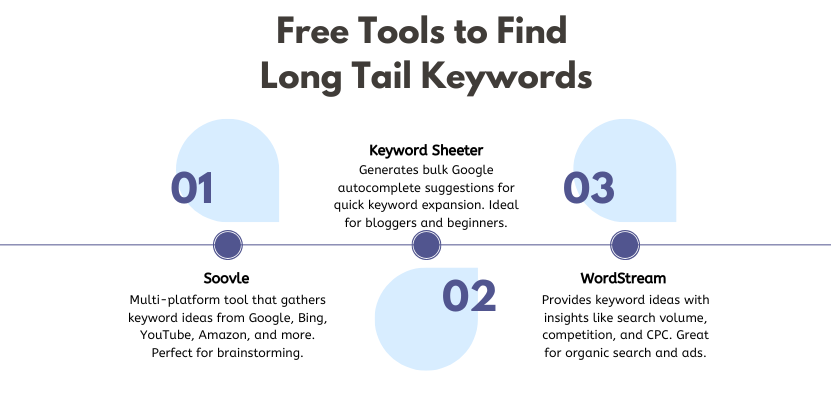
1. Free Long Tail Keyword Generator Tools
These SEO tools are super handy and easy to use. Just type in a topic or word, and they’ll give you a bunch of long tail keyword ideas. Here are some free long tail keyword generator tools, you should check out:
1. Soovle
Soovle is a free, multi-platform keyword suggestion tool. It gathers keyword ideas from multiple sources like Google, Bing, YouTube, Amazon, Wikipedia, and Yahoo, all in one place. It’s simple to use and perfect for brainstorming long tail keyword ideas.
2. Keyword Sheeter
Keyword Sheeter generates thousands of autocomplete keyword suggestions directly from Google. It’s designed to provide a bulk list of keywords quickly, which is great for brainstorming long tail keyword ideas. It’s ideal for bloggers, marketers, and SEO beginners who need a quick way to expand their keyword lists.
3. WordStream Free Keyword Tool
WordStream’s Free Keyword Tool generates keyword suggestions for both organic search and paid ads. It provides insights like search volume, competition level, and cost-per-click (CPC) to help you choose the right keywords for your goals. The added insights into competition and CPC make it a versatile tool for planning campaigns on a budget.
Start with one of these tools and play around with different phrases. You’ll get loads of inspiration for your content!
2. Explore Google’s Free Features
Google itself is a powerful tool for finding long tail keywords. Here are some free features you can use to your advantage:
- Google Autocomplete: Type your main keyword into the Google search bar and observe the autocomplete suggestions for long-tail phrases.
- People Also Ask (PAA): Use questions and queries from the “People Also Ask” box for inspiration.
- Related Searches: Scroll to the bottom of the search results page to find related search terms.
- Google Trends: Analyze trending topics and narrow them down to specific long-tail keywords.
3. Leverage Forums and Communities
Forums and online communities are great places to find long tail keywords. People often ask questions or discuss specific topics, giving you valuable insight into what your target audience is searching for.
- Explore platforms like Reddit, Quora, and niche-specific forums. Look for commonly asked questions and discussions, which often provide insight into long-tail search queries.
- Use tools like Keyword Surfer (a browser extension) to estimate the search volume for these queries directly.
Common Mistakes to Avoid When Using Long Tail Keywords
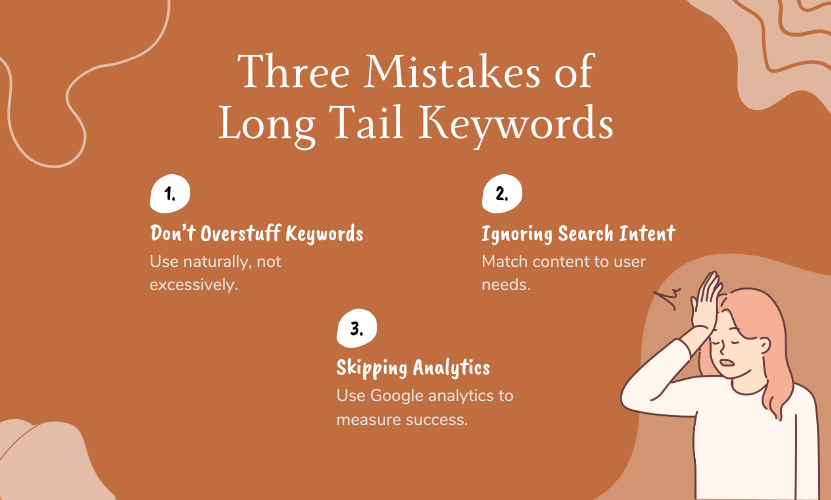
It’s easy to get excited about the benefits of long tail keywords, but if you’re not careful, you could make mistakes that hurt your SEO instead of helping it. Don’t worry, though—I’ve got your back. Here are some common mistakes to watch out for (and how to avoid them).
1. Don’t Overstuff Keywords
We’ve all heard “the more, the better,” but that’s not true when it comes to keywords. Stuffing your content with too many keywords can make it sound unnatural and even annoy your readers. Worse, search engines might penalize your site for trying to “trick” the system.
What to Do Instead:
Use your long tail keywords naturally. Write like you’re talking to a friend, and make sure your content flows. If it feels forced, leave it out.
Example of Forced Keyword:
“Best running shoes for beginners with flat feet are what we sell.”
Natural Version:
“We offer some of the best running shoes for beginners with flat feet to help you run comfortably.”
2. Ignoring Search Intent
Here’s a big mistake: using keywords without thinking about what people actually want. For example, someone searching for “best hiking boots under $100” is ready to buy, but if your content just lists random boots without prices, they’ll leave your site fast.
What to Do Instead:
Focus on what the searcher is really asking. If they want product recommendations, give them that. If they’re looking for a how-to guide, provide step-by-step instructions. Matching the intent behind the keyword is key.
3. Skipping Analytics
How do you know if your keywords are working? You can’t just guess—you need to check the data. If you’re not tracking things like clicks, traffic, and conversions, you might be wasting time on the wrong keywords.
What to Do Instead:
Use free tools like Google Analytics or Google Search Console to see how your keywords are performing. If something isn’t working, tweak it. SEO is all about testing and improving over time.
Final Thoughts: Why Long Tail Keywords Are a Game-Changer
If you’ve made it this far, you now know the benefits of long tail keywords and how to create long tail keywords for your website and SEO strategy. Start experimenting with long tail keywords. Use a free generator to get long tail keyword ideas and see what works best for your website.
If you’re feeling stuck or want expert help, don’t hesitate to reach out to Rankonix. We’re here to make your SEO journey easier and more effective. Remember, small changes like using long tail keywords can make a big difference. So, why not start today? You’ve got this!
Have you tried using long tail keywords? What’s your favorite tool or tip? Share your experiences in the comments below—we’d love to know how they’ve worked for you!
FAQs
Q: Why are long tail keywords better for beginners in SEO?
A: Long tail keywords are perfect for beginners because they’re less competitive. This means it’s easier for small websites or new blogs to rank for them. Plus, they target specific searches, so you’re more likely to attract the right audience who are ready to engage or make a purchase.
Q: How do long tail keywords differ from short-tail keywords?
A: Long tail keywords are longer, more specific phrases, like “best hiking boots for snow,” while short-tail keywords are like “hiking boots.” Long tail keywords target detailed searches, making them better for conversions because they match what people are actually looking for.
Q: How many long tail keywords should I use in a blog post?
A: It depends on the length of your blog. For shorter posts (around 500-700 words), use 1-2 long tail keywords naturally. For longer posts (1,500+ words), aim for 3-5, spreading them out in the headings, subheadings, and body. The key is to keep it natural and avoid overstuffing.
Q: Can long tail keywords improve my click-through rate (CTR)?
A: Yes! Long tail keywords are specific, so they attract users who are more likely to click because your content directly matches what they’re looking for. Adding them to your meta titles and descriptions can make your links more appealing in search results.
Q: Are benefits of long tail keywords only for small businesses?
A: Not at all! While they’re great for small businesses and new websites, big brands also use them to target niche audiences, answer specific questions, and dominate more search results. They’re a smart choice for businesses of all sizes.


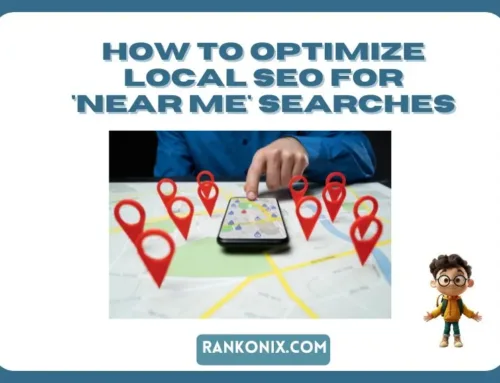

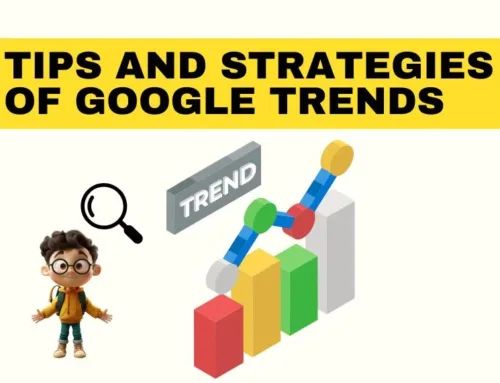



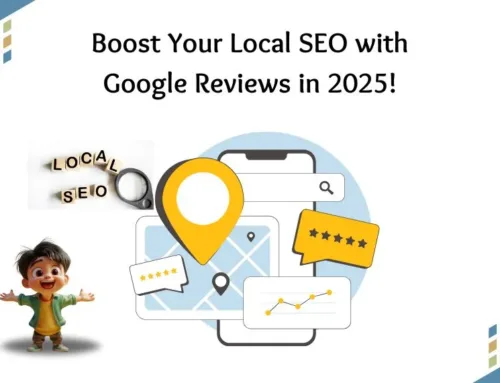

[…] How to Use Google Trends for Long-Tail Keyword Research […]